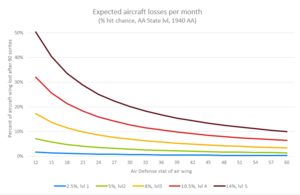空军作战是用来模拟每8个小时(在每天的08:00、16:00和24:00)。取决于发生的地点和每年的时间,这可能导致白天和晚上发生不同次数的战斗。 每个国家都会顺次完成下列每个阶段。
探测,造成伤害与干扰阶段
在此阶段,我方空军联队将尝试攻击敌方,既包括直接攻击对方造成伤害,也包括干扰敌方执行地面任务。敌方国家包括任何交战国家和敌方志愿航空队的派遣国家(在拥有![]() 唤醒猛虎dlc时)。但要想攻击敌方飞机首先需要具备探测敌方飞机的能力。
唤醒猛虎dlc时)。但要想攻击敌方飞机首先需要具备探测敌方飞机的能力。
探测几率取决于若干因素:
- 占领:占领相应空域的领土可以从地面探测飞机,至多提供10%的探测几率(在控制空域内全部地区时)。
- 雷达:雷达覆盖区域可以提供至多50%探测几率(在雷达全覆盖时)。
- 空军任务:空军在该空域执行任务可以提供至多80%的探测几率(当有3000架飞机执行任务时,非战斗机仅提供一半的贡献)。
- (以上三个因素为叠加)
- 夜晚:降低20%
- 不良天气:降低至多90%
只有这个百分比的敌方飞机是可见的。可见飞机的数量可被进一步修正:
- 如果敌方既有地面任务飞机也有夺取制空权的战斗机,后者将会完全可见。这些战斗机和轰炸机不必来自同一国家。
- 执行战略轰炸任务的常规轰炸机和舰载轰炸机(
舰载机能战略轰炸??)通过“战略轰炸可见性”进行修正(渗透轰炸学说:-50%)。 - 执行近地支援任务的飞机可见性翻倍。
- 执行港口袭击任务的飞机可见性为十分之一。
在敌人可见的情况下,最多3倍于敌方的飞机可以进行攻击,因此良好的探测对于充分利用空军联队非常重要,特别是在敌人飞机较少的时候。
如果没有执行地面任务,敌方执行拦截任务的飞机将不会被视为目标。相对的,敌方没有执行地面任务时,我方拦截机也不会攻击。主动参加战斗的舰载机(如指派夺取制空权任务)可以将敌方参与海战中的所有舰载机视为攻击目标。双方的空军联队每架飞机会分别为其国家产生0.075点国家空军经验。这意味着如果一支空军同时打多个国家的空军会产生多倍的经验哪个国家的飞机我没有打过。
所有打算攻击的联队会获得0.4点联队经验。所有联队会按照对空攻击和机动从高到低的顺序顺次对探测到的敌人出击,因此战斗机和重型战斗机将会造成绝大多数伤害。但如果探测到足够的敌人,轰炸机也可以造成伤害。
出击联队中的飞机将会根据敌人联队可见度成比例进行分配(对所有联队的伤害以及对地面任务联队的干扰)。 下列组成部分会对最终伤害值产生影响:
- 攻击方的对空攻击
- 防御方的对空防御
- 属性乘数:双方速度差值除以1500千米/小时,加上双方机动的差值除以100。将这个结果限定在[-100%,100%]范围内,再乘以30%得到。举个栗子,36年战斗机打36年战术轰炸机会得到[math]\displaystyle{ ((500-430)/1500 + (50-20)/100)*0.3=10.4 }[/math]%的加成。
- 舰载因子:普通情况下为0.1,舰载飞机战斗为6(如果攻击方和防御方均为舰载联队的情况下)。
- 机动劣势:如果防御方的机动更高,攻击方会受到最高-67.5%的惩罚。受到最高惩罚时己方与敌方机动比率为1:2.5。
[math]\displaystyle{ \text{伤害} = 0.01 * \text{攻击方的数量} * \text{对空攻击} / \text{对空防御} * (1 + \text{属性乘数}) * \text{舰载因子} * (1 + \text{机动劣势}) }[/math]
由此可见,在双方任务效率均为100%时,重型战斗机由于机动的问题会在与战斗机的空战中处于不利地位,且这种差距伴随科技提升进一步被放大,44重型战斗机对阵44战斗机会非常吃瘪。但尽管如此,在与其他机动不佳的飞机战斗以及在空域范围较广的地区战斗时,重型战斗机的航程优势可能仍然会比战斗机效果更好(如亚洲地区通常更适合重型战斗机)。
下列组成部分会对最终干扰值产生影响:
- 攻击方的速度影响:攻击方的速度除以1500。
- 探测几率
- 舰载因子:普通情况为4,舰载飞机战斗为8(仅在攻击方和防御方均为舰载联队的情况下)
[math]\displaystyle{ \text{干扰} = \text{攻击方数量} * (1 + \text{速度影响}) * (1 + \text{对空探测}) * \text{舰载因子} }[/math]
这使得探测对于干扰来说至关重要,因为它既增加了对敌方轰炸机攻击的战斗机数量,同时也增加了每架飞机的干扰影响。
装备损失与护航阶段
指派护航/夺取制空权任务的战斗机会抵消轰炸机受到的敌方在干扰阶段带来的干扰影响。盟友国家的战斗机是不会得到护航的()。下列组成部分会对护航抵消干扰效果产生影响:
- 基础:2
- 速度因子:速度除以1500
- 机动因子:机动除以100
- 攻击因子:攻击除以100
- 探测
[math]\displaystyle{ \text{干扰降低比率} = 2 * \text{护航飞机数量} * (1 + \text{速度因子}) * (1 + \text{机动因子}) * (1 + \text{攻击因子}) * (1 + \text{探测}) / \text{总计干扰量} }[/math]
所有轰炸机联队受到的干扰影响将按照这个比率移除。这一阶段不会重新计算主动护航的飞机数,而是按照上一阶段该国尚未被使用的飞机数量,这会导致一些国家护航效率会低的离谱。
如果一支由王牌飞行员领导的联队至少损失了一架飞机,他们就有几率在空战中阵亡。这个几率= 损失的飞机数 * 0.001 * 0.1 + 0.003。但由于四舍五入的问题,除非一次战斗该联队损失10架以上的飞机,否则这个概率通常就是0.3%。也就是说,一个王牌飞行员的存活期望是经受230次损失。
上一阶段每点受到的伤害会导致一架飞机的损失。不足1点的部分是按概率计算的,即遭受1.2点伤害时80%的概率只损失一架飞机,20%的概率会损失两架飞机,因此期望损失的飞机数为1.2架。
地面任务阶段
Other planes perform their missions, such as close air support, strategic bombing etc. They gain 0.28 wing experience. Disruption reduces the effectiveness of these missions. Wings may take additional losses in this phase from state, naval, or divisional anti-air.
All ground missions except para drop and mine planting/sweeping require the selection of a specific target. If multiple missions are selected, they are tried in the following order:
- close air support
- strategic bombing
- naval bomber/kamikaze
- port strike
- air supply
Only the first category that produces a valid target is used, but a single wing can handle multiple targets within the same category in one sortie. It is not necessary to split up wings to support multiple land combats for example. But a large naval bomber wing can for example not send any remaining planes on a port strike when another part of the wing executed a naval strike.
Night time's "Ground Bombing Targeting" modifier (-50%) causes a corresponding probability of the wing being unable to find their target. They are still subjected to state AA.
区域防空火炮
Strategic bombing, port strike and air supply missions are affected by state anti-air (AA).
The probability that a damage event occurs (C) and the number of planes destroyed (D) depend on the following components:
- damage base chance: 10%
- hit chance modifier: the "Static Anti Air hit chance factor" modifier (three radar technologies provide +20% each)
- a random number R between 0.0% and 100.0%
- damage factor: 0.8
- anti-air factor: for air supply missions, the AA value of their target's state (even when that state is friendly) divided by the maximum AA level (5). For the other two mission types, the average AA level in enemy states in the strategic region, divided by the maximum AA level (5).
- effective number of planes
- damage modifier: the "Static Anti Air damage factor" modifier (+10% each from anti-air 2 and 3 technologies)
- air wing's defense stat
[math]\displaystyle{ C = 10% * (1 + \text{hit chance modifier}) * \text{anti-air factor} }[/math]
If R is smaller than C, a hit occurs with the following damage (in number of planes destroyed):
[math]\displaystyle{ D = max(1, \frac{0.8 * \text{anti-air factor} * \text{number of planes} * R * (1 + \text{damage modifier})}{C * \text{air wing's defense}}) }[/math]
Or averaging the random number [math]\displaystyle{ R }[/math] to [math]\displaystyle{ C/2 }[/math]:
[math]\displaystyle{ D = max(1, \frac{0.4 * \text{anti-air factor} * \text{number of planes} * (1 + \text{damage modifier})}{\text{air wing's defense}}) }[/math]
Small bomber wings and especially strategic bombers (having high air defense) will be frequently affected by the minimum-one loss.
干扰伤害要素
The ground mission wing can reduce any disruption left over after the escort phase further using its own stats. Finally the disruption produces a damage factor that scales the damage the mission can actually do. It uses the following components:
- disruption: value after the escort phase
- defense factor: air wing's defense divide by 200
- attack factor: air wing's attack divided by 200
- speed factor: air wing's speed divided by 1500
- air wing's number of planes (not reduced by mission efficiency)
[math]\displaystyle{ \text{disruption damage factor} = 100\% - \sqrt{\frac{\text{disruption}}{10 * \text{number of planes} * (1 + \text{defense factor}) * (1 + \text{attack factor}) * (1 + \text{speed factor})}} }[/math]
The value that gets reported as "Planes disrupted" in the statistics of an air region is [math]\displaystyle{ \text{number of planes} * (1 - \text{disruption damage factor}) }[/math] accumulated over all missions and sorties in the time frame.
Guided missiles always have a disruption damage factor of 100%, ignoring any disruption applied against them.

